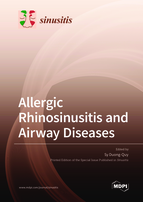Olfactory Disorders in Post-Acute COVID-19 Syndrome
Round 1
Reviewer 1 Report
This paper focuses on the aspects of olfactory impairment in post-acute COVID-19 Syndrome, including its pathophysiology, epidemiology, and clinical management. The authors reviewed many papers analyzing COVID-19-related olfactory dysfunction, and summarized them very well. This is a necessary review article for the current situation, and thank you for your hand work. The following are the ones that may need to be corrected.
1. In Table 1, please indicate the unit in Time. (days)
2. Because it is a review journal, outcomes of previous papers must be accurately recorded. In table 1, it seems that the Outcome of S4 (Jacobs 2020) needs to be corrected. On the 35th day, there were 17 patients with lack of smell, and 9.3% (17/183) of them were correct (not 26.2%).
3. [S11] in Table 1 and [S11] in ‘Supplementary References’ are not the same. Please check this part.
4. Is Figure 1. drawn by the authors themselves? If you have any issues with copyright, please let us know.
5. Please check the followings in the text and unify them into one
COVID-19 or COVID19 / SARS-CoV-2 or SARS-CoV 2
Author Response
We are grateful to the reviewer for their insightful comments on our paper. We have been able to incorporate changes to reflect most of the suggestions provided by the reviewer. Here is a point-by-point response to the reviewers' comments and concerns.
Point 1: In Table 1, please indicate the unit in Time. (days)
Response 1: Revised accordingly.
Point 2: Because it is a review journal, outcomes of previous papers must be accurately recorded. In table 1, it seems that the Outcome of S4 (Jacobs 2020) needs to be corrected. On the 35th day, there were 17 patients with lack of smell, and 9.3% (17/183) of them were correct (not 26.2%).
Response 2: We appreciate this recommendation. We agree with the reviewer that 9.3% is the accurate data.
Point 3: [S11] in Table 1 and [S11] in ‘Supplementary References’ are not the same. Please check this part.
Response 3: Modified in S11 to “Paderno, A., Mattavelli, D., Rampinelli, V., Grammatica, A., Raffetti, E., Tomasoni, M., ... & Schreiber, A. (2020). Olfactory and gustatory outcomes in COVID-19: a prospective evaluation in nonhospitalized subjects. Otolaryngology–Head and Neck Surgery, 163(6), 1144-1149.”
Point 4: Is Figure 1. drawn by the authors themselves? If you have any issues with copyright, please let us know.
Response 4: Figure 1 was drawn by the authors. To our knowledge, there is no copyright issue to be declared.
Point 5: Please check the followings in the text and unify them into one COVID-19 or COVID19 / SARS-CoV-2 or SARS-CoV 2
Response 5: The terms COVID-19 and SARS-CoV-2 were unified in the manuscript
Author Response File: ![]() Author Response.pdf
Author Response.pdf
Reviewer 2 Report
The manuscript “Olfactory Disorders in Post-acute COVID19 Syndrome” aims to evaluate aspects of olfactory impairment, including its pathophysiology, epidemiology, and clinical management in post-acute COVID-19 Syndrome.
The Manuscript is well written, newsworthy and clear to understand, but requires some minor revisions.
Specific observations:
Line 79 Authors should indicate a reference.
Line 120 It should be “Figure 1”
Line 126 It should be “COVID -19”
Authors should use the same definition COVID -19 or COVID 19 in the Manuscript
In the table 1 Authors should define these acronyms [S4], [S5] etc…
In table 1 outcome should be changed in frequency of olfactory and or gustatory dysfunction
Author Response
We are grateful to the reviewer for their insightful comments on our paper. We have been able to incorporate changes to reflect most of the suggestions provided by the reviewer. Here is a point-by-point response to the reviewers' comments and concerns.
Point 1: Line 79 Authors should indicate a reference.
Response 1: We appreciate this recommendation. Reference “Makaronidis J, Firman C, Magee CG, Mok J, Balogun N, Lechner M, et al. Distorted chemosensory perception and female sex associate with persistent smell and/or taste loss in people with SARS-CoV-2 antibodies: a community based cohort study investigating clinical course and resolution of acute smell and/or taste loss in people. BMC Infect Dis. 2021;21(1):1–11.” Was included at the end of this sentence
Point 2: Line 120 It should be “Figure 1”
Response 2: We appreciate this recommendation. Revised accordingly.
Point 3: Line 126 It should be “COVID -19”
Response 3: We have revised the paper accordingly.
Point 4: Authors should use the same definition COVID -19 or COVID 19 in the Manuscript
Response 4: The term COVID-19 was unified on the manuscript
Point 5: In the table 1 Authors should define these acronyms [S4], [S5] etc…
Response 5: We have clarified this point in the table’s footnote as follows: “[S] Suplemmentary Reference”
Point 6: In table 1 outcome should be changed in frequency of olfactory and or gustatory dysfunction
Response 5: The table’s header row now reads “Prevalence of olfactory/gustatory dysfunction”
Author Response File: ![]() Author Response.pdf
Author Response.pdf




